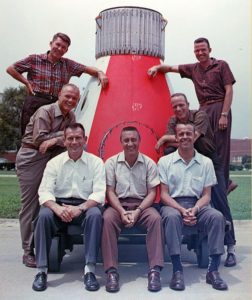
The Mercury Seven astronauts. Front row, left to right: Deke Slayton, Gus Grissom, and Alan Shepard. Second row: John Glenn and Scott Carpenter. Third row: Wally Schirra and Gordon Cooper (NASA photo)
Last week’s article talked about Scott Carpenter, Gordon Cooper, John Glenn, and Gus Grissom, four of the original Mercury Seven astronauts. This week’s article touches on the other three astronauts.
1. Wally Schirra won a Clio advertising award.
Imagine having a cold in space. Navy Captain Wally Schirra knew what it was like
In October 1968, Schirra was commander of Apollo 7, the first flight in which the Saturn rocket was being tested and the last flight before actually going to the Moon. (Apollo 8 would have that distinction.) But Schirra wasn‘t feeling well, and it led to tensions with NASA officials on whether he needed to wear his helmet for the reentry. (He ultimately didn’t wear it.)
Apollo 7 was Schirra’s last flight. He later became a space commentator for CBS News, sitting alongside Walter Cronkite to describe what was happening on the Apollo missions.
In the 1980s, Schirra made a series of commercials for Actifed, a nasal decongestant he used during the mission. In one ad, he helps an astronaut put on a helmet and asks the viewer, “Did you ever try sneezing in one of these?” Schirra won a Clio, an advertising award, for that ad.
Schirra died in 2007.
2. Alan Shepard was the only one of the Seven who walked on the Moon.
Navy Commander Alan Shepard could claim two distinctions among the Seven. He was the first American to fly in space, flying aboard the Freedom 7 spacecraft on a suborbital mission in 1961. But perhaps he’s better remembered for his command of Apollo 14, which in 1971 made the first return flight to the Moon after the “successful failure” of Apollo 13 in April 1970.
Shepard and lunar module pilot Ed Mitchell walked on the Moon while the command module pilot, Stu Roosa, flew overhead.
Before leaving the Moon, Shepard produced a golf ball and, using one of the tools used for lunar (with a six-iron attached), played a little golf. See the YouTube video at https://www.youtube.com/watch?v=f-FxhCZold0.
Shepard died in 1998.
3. Deke Slayton chose who got to fly.
Air Force Major Donald “Deke” Slayton was all set to make his flight. He would be the fourth American in space, following Shepard, Grissom, and Glenn. Or so he thought.
NASA doctors discovered Slayton had a heart fibrillation, and ordered him grounded. Carpenter took his flight, and there was no word when, or it, Slayton might get to fly in space.
It was about this time, 1962, when NASA decided it needed an officer to head up the astronaut office. Slayton was the choice in part because he was an astronaut, never mind his being grounded. But Slayton proved himself as a very able administrator, and he had the responsibility of choosing which astronaut crews made what flights.
In 1975, his health issues were cleared and he had a chance to fly on the Apollo-Soyuz Test Project, where spacecraft from the United States and Soviet Union docked in space. Slayton was the last of the Mercury Seven to fly in space.
Slayton died in 1993.
